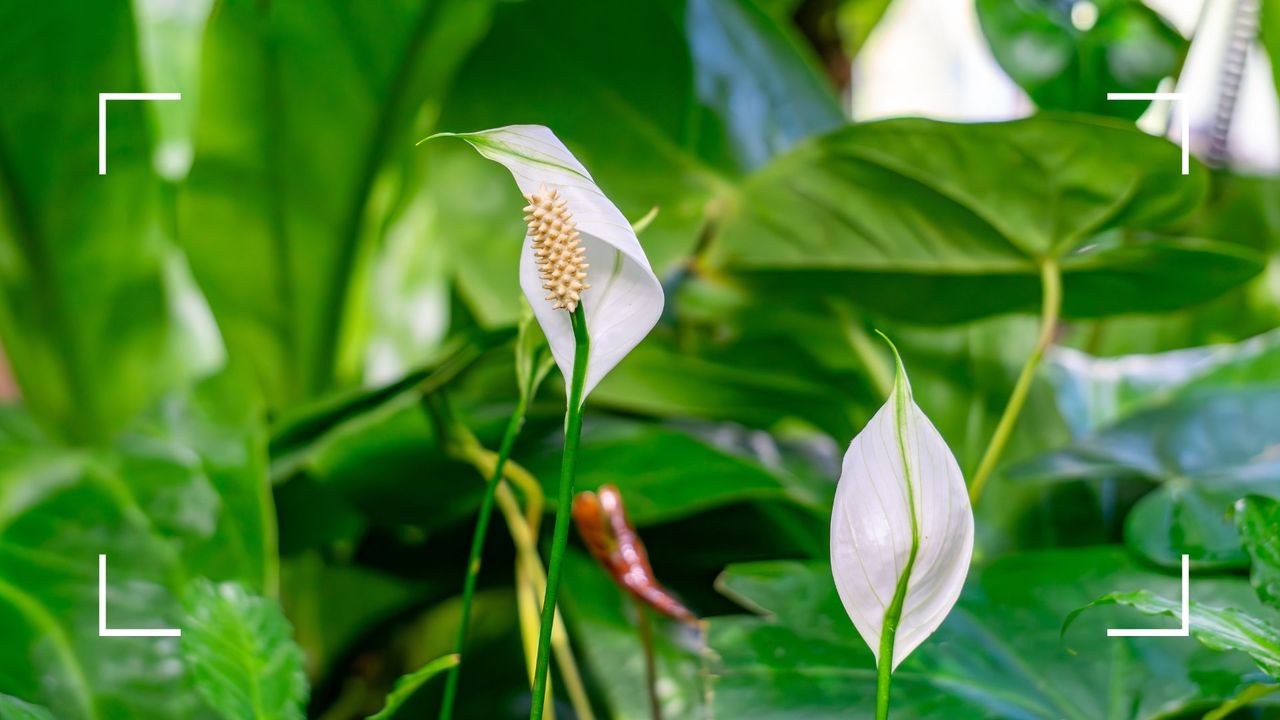
Master how to care for a peace lily correctly, and these beauties will reward you by flourishing in your home. If you're a new plant parent, put it at the top of your houseplant wish list for its easy-care nature and elegant good looks.
The easy-going peace lily is a fabulous starter houseplant for beginners. It might not make the list of the most fragrant houseplants to make your house smell good, but it is one of the best indoor plants for health and wellbeing.
After all, there aren’t many houseplants that bloom happily in low light levels, or have the ability to act like one of the best air purifiers by removing pollutants. This makes them a must-have for your new plant collection.
Even though the peace lily is low maintenance and super easy to cultivate, you'll still want to make sure you max up your plant’s potential by following our expert tips on how to care for a peace lily.
How to care for a peace lily: 6 easy steps
The peace lily is an elegant and popular choice for indoor flowering plants, bringing a touch of tranquillity to any space.
"With beautiful, white flowers and a calming ambience, the peace lily is a gorgeous houseplant to add to your collection," says Jo Lambell, founder of houseplant specialists Beards & Daisies.
"You’d be forgiven for thinking it may be difficult to care for, judging by its stunning appearance; however, it's very low maintenance and also a fantastic air purifier. According to the ancient art of feng shui, peace lilies can cleanse the energy of a room, bringing peace and tranquillity to your home." And it's not nearly as tricky as mastering how to care for an orchid.
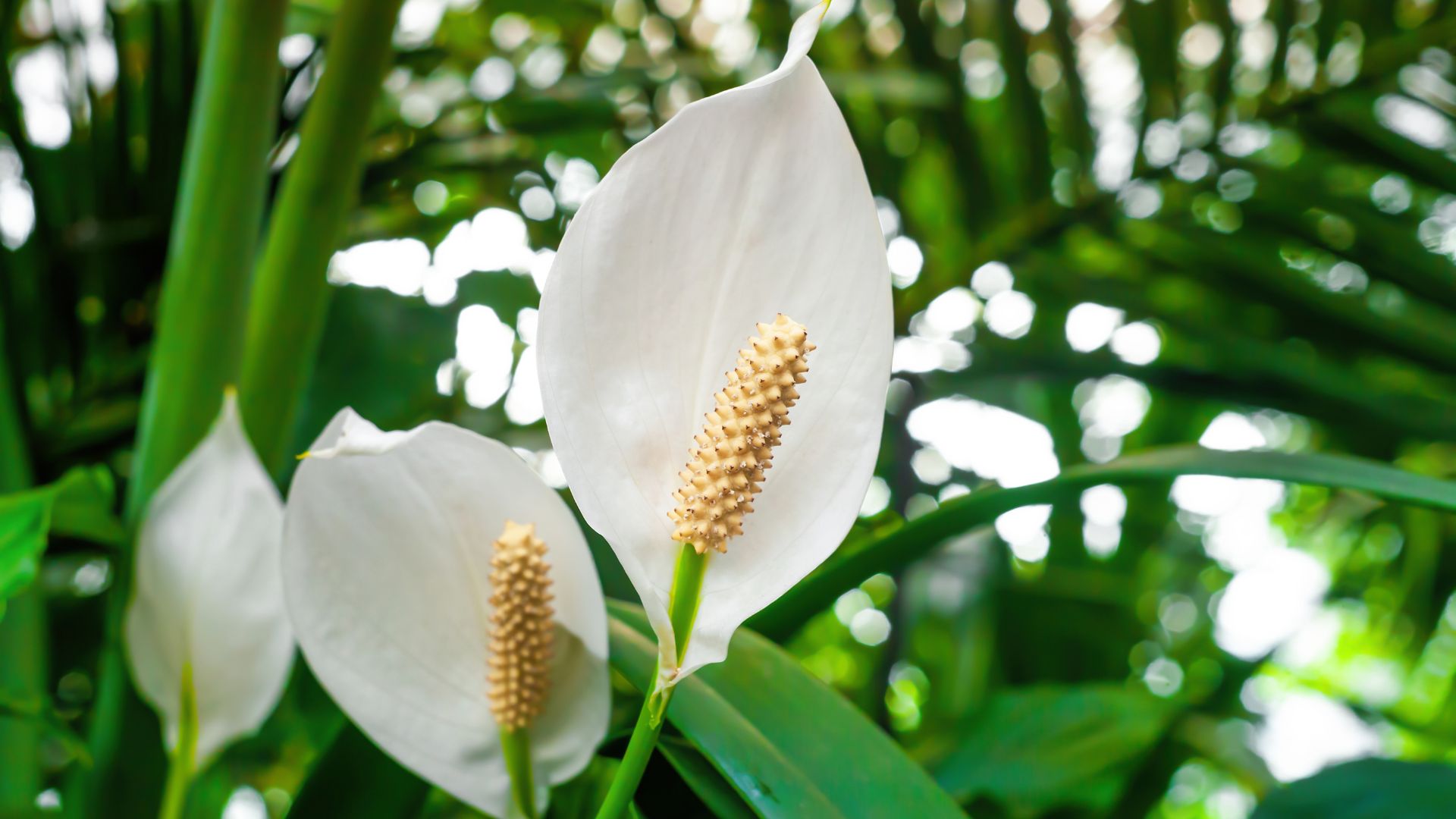
Originating from South America, its mass of dark, glossy leaves and spikes of beautiful white flowers will certainly add a tropical look to your plantscape. The tear-shaped flower isn’t really a flower at all but a ‘spathe’ (Greek for leaf) and this is where the plant gets its botanical name (Spathiphyllum) from. It's the combination of glossy leaves and elegant white flowers that makes this houseplant a timeless classic.
Follow our easy beginner's guide on how to care for a peace lily and discover the ideal growing conditions, as well as how to avoid the most common houseplant mistakes. Then you'll be able to keep your precious plant looking beautiful for months to come.
1. Choose the right location for your peace lily
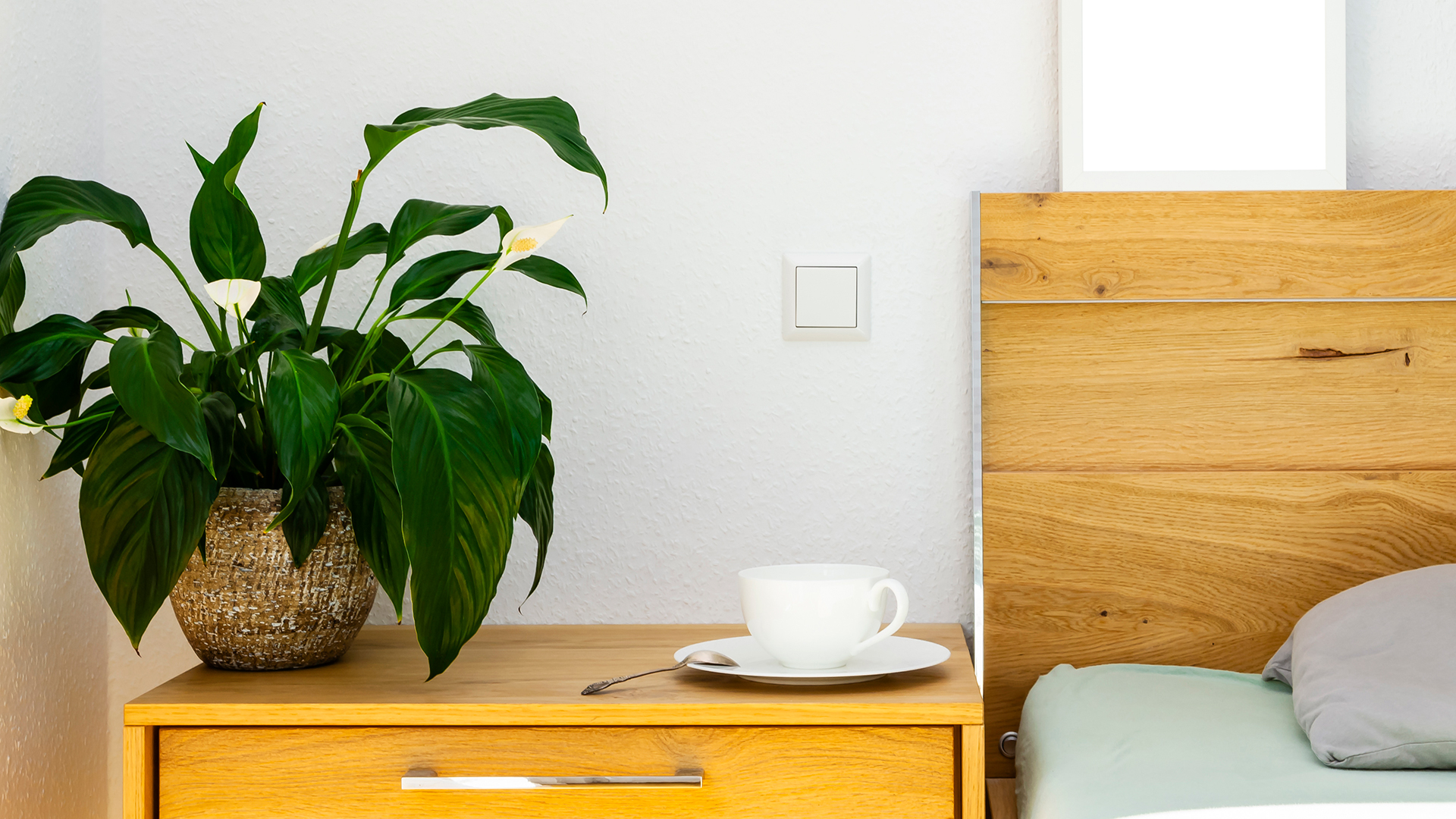
It's best to keep your peace lily out of direct sunlight, as it does best in a lightly shaded spot. In fact, these plants can withstand very low light levels, but this doesn’t necessarily mean it's ideal for them. If you want flowers to bloom, they need bright, indirect light. While it can cope with lower light, you may notice your peace lily doesn't flower in these conditions.
An essential part of caring for a peace lily is to keep your plant out of direct sun in summer to avoid burning and scorching the leaves, and the flowers drying out. Similar to what causes monstera leaves to turn brown.
Ensure your peace lily is kept at a minimum winter temperature of 10˚C, although it can survive if the temperature drops a little lower. But remember the peace lily comes from the tropics, so make sure you keep it away from draughts and doors to avoid mould on the soil. Generally, these plants are trouble-free and require little upkeep, meaning they stay beautiful for years if cared for properly.
2. Get the watering needs right
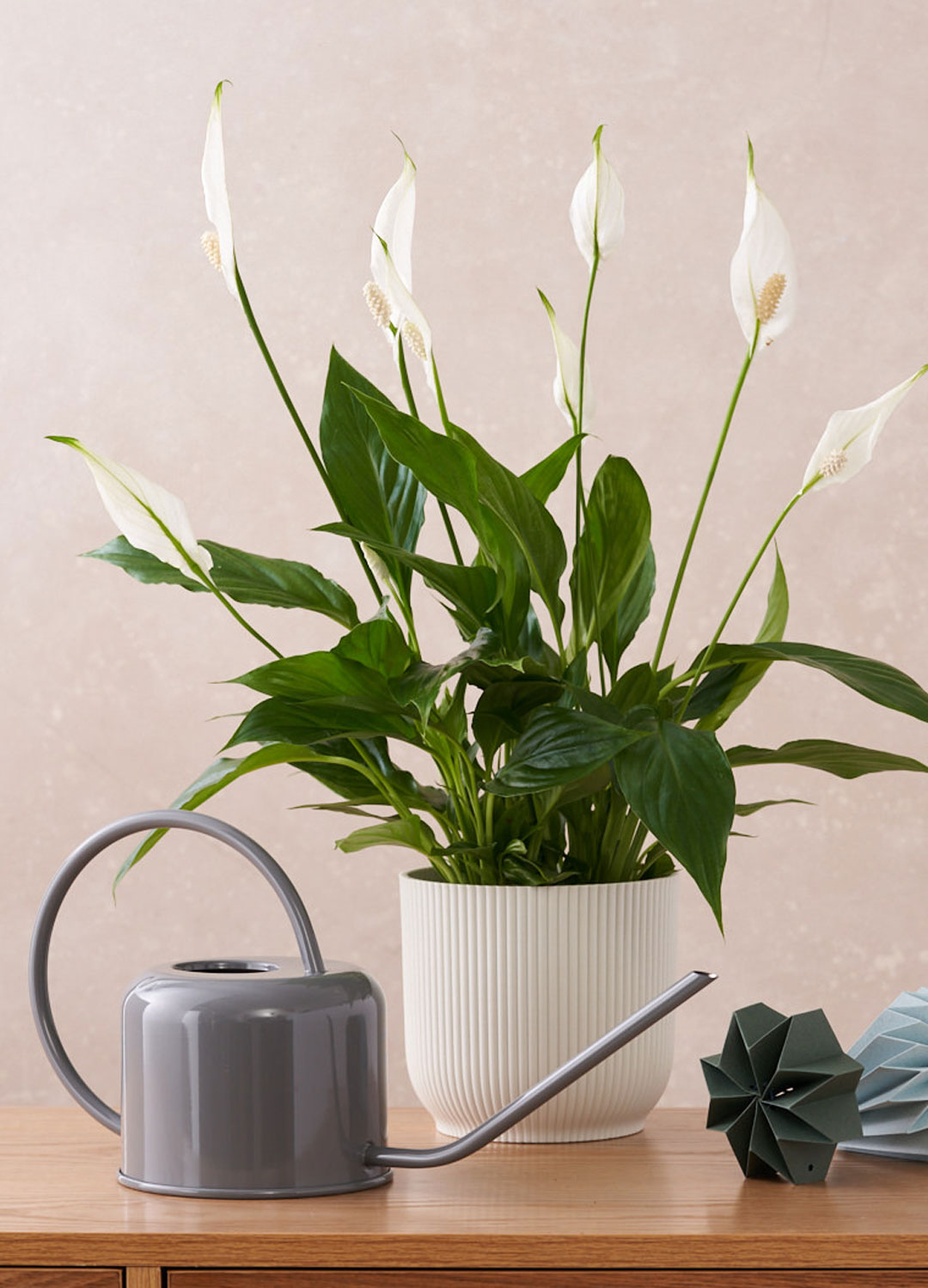
How often you water any houseplant, particularly the peace lily plant, depends on the indoor temperature and the season. Your plant will soon let you know when it needs watering, as leaves will start to droop.
“You can gauge when to water your peace lily by feeling the top inch of soil, and only water your plant when it has dried out," says Claire Bishop, senior houseplant buyer at Dobbies. "Then, to ensure your plant gets the hydration it needs, consider placing it in a sink or the bath, and giving it a thorough soaking until water runs out of the bottom of the drainage container."
These plants are not keen on tap water, particularly if you live in a heavily chlorinated area, so it’s a good idea to let tap water stand before using it so that the chlorine can evaporate a little.
Alternatively, use rainwater harvesting to collect water in the garden. This 100L Water Butt with Stand and Tap for £34.99 from Amazon is a great budget solution to get started.
Top tip: Always use room temperature water to avoid a cold shock for your plant.
Let your peace lily dry out between waterings, but don’t let it get to the stage where the leaves start to wilt. Don’t leave your plant sitting in a saucer of water either, as this can lead to the roots rotting. Keep the compost damp all year round and water more often in summer, cutting back to fortnightly during the winter months. If you're wondering why my peace lily is drooping, give it a thorough watering, and it will soon revive.
RRP: £23.49 | The long, thin spout on this watering can makes it easy to get a good pour into any of my plant pots, and the spray bottle is a priceless addition for houseplant watering.
3. Keep conditions humid
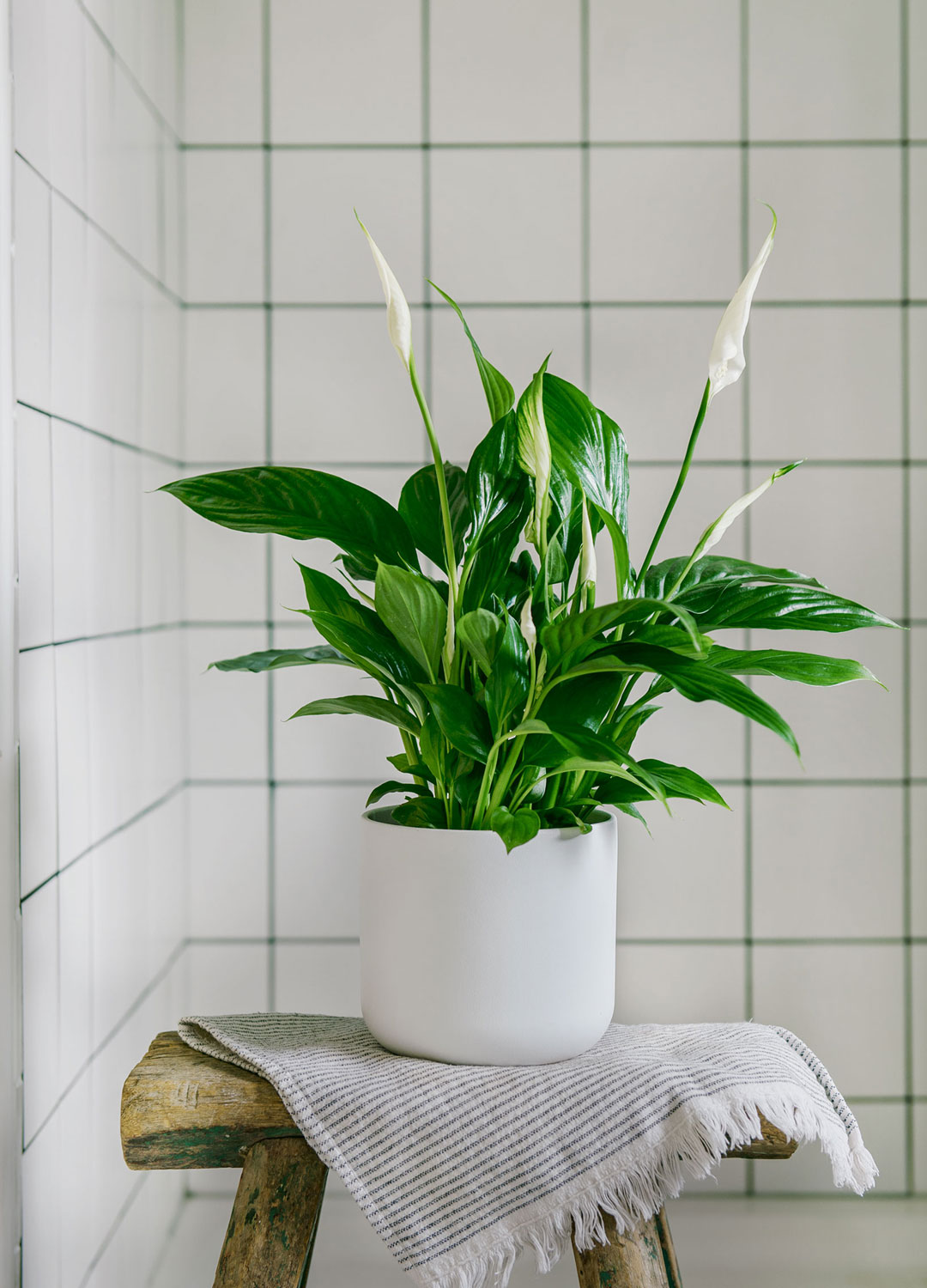
Peace lilies are one of the best plants to help with condensation. As they're native to tropical rainforests, peace lilies thrive in high humidity, so mist yours regularly or keep it in a bathroom, where all those lush leaves will create the feeling of a spa-like sanctuary. Your plant will enjoy the steamy atmosphere generated by the shower or bath.
"A light-filled bathroom is the perfect spot for most peace lilies as they’ll thrive in the humidity," says Claire Bishop. "However, if you prefer to style your plant elsewhere, a regular misting will keep its leaves glossy and mimic the tropical climate it’s used to.”
Alternatively, mist the leaves regularly to replicate the conditions enjoyed by your plant and it will return the favour by growing lots of lush leaves. Putting a tray with moistened gravel underneath your peace plant will also help boost humidity levels.
RRP: £5.99 | This affordable Indoor thermometer can accurately monitor humidity levels with ease and is ideal for keeping those tropical plants happy.
4. When to feed your plant
The peace lily is not a demanding plant when it comes to food. In fact, over-fertilising could harm it by burning the roots. Another key part of how to care for a peace lily is never applying fertiliser to dry soil, as this may also scorch the roots. However, this doesn't mean your plant won't benefit from a little boost now and then.
"Peace lily plants will appreciate being fed once a month with a balanced houseplant food throughout the growing season, from spring to late summer, after which they go into dormancy and stop putting on growth," says Kelly Dryer, plant doctor at Patch Plants.
Try the quirky Miracle-Gro 1002522 Indoor Plant Food Spikes from Amazon to take the hard work out of feeding your plant. Alternatively, following how to use banana peel in the garden, you can make a nutrient-rich liquid fertiliser to water your indoor plants too.
If you feed your plant more often, for example, because it has lots of flowers, use a very diluted fertiliser, as overfeeding can cause brown spots on the leaves or the flowers themselves to turn a mix of green and white instead of pure white.
RRP: £3.70 | We all have our favourite plant foods (you can even mix sugar and water at home), but if yours is looking a little worse for wear, this is a miracle worker.
5. Keep your plant looking good
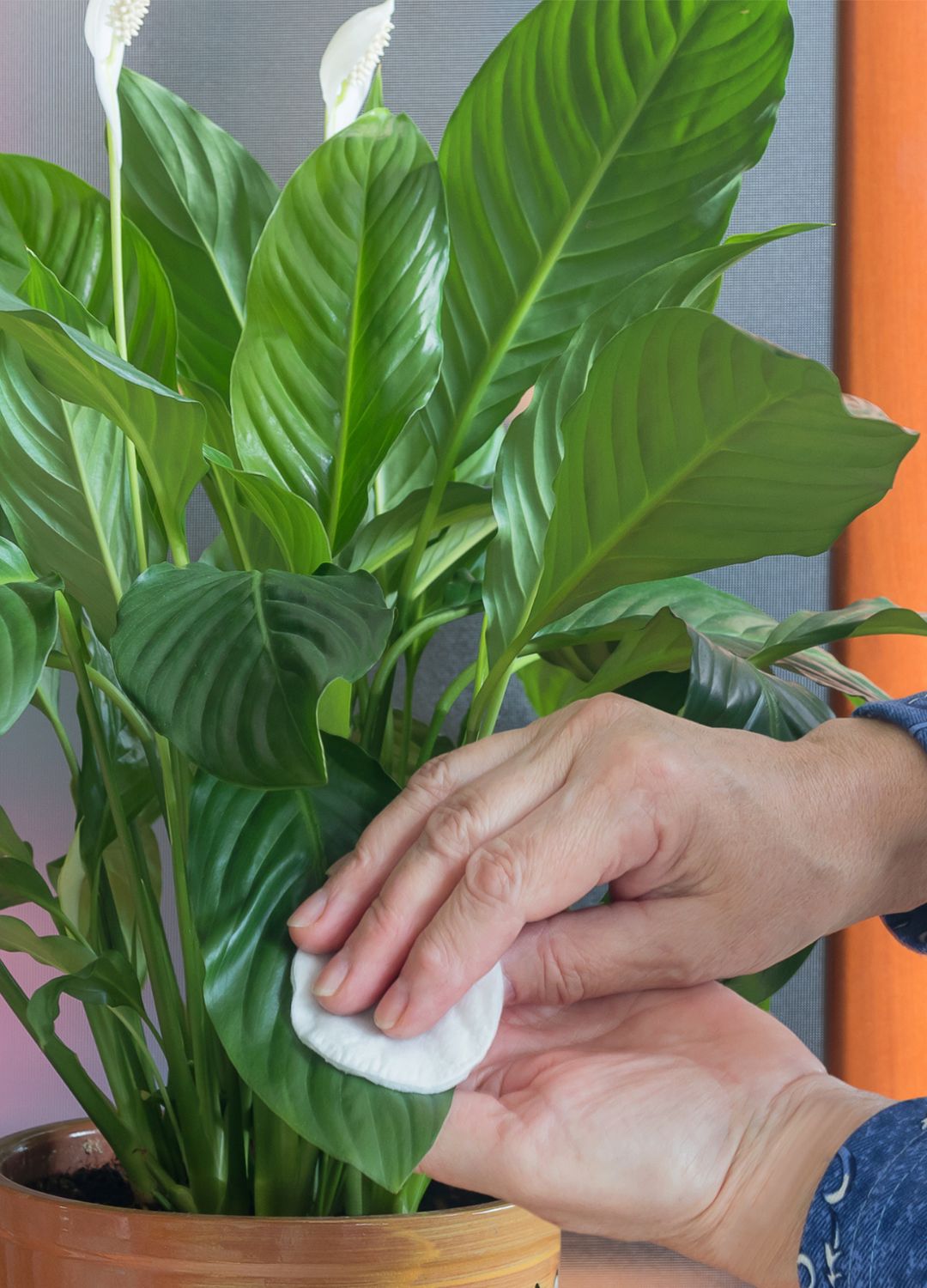
It's essential to master how to clean plant leaves, as it's important to regularly dust leaves or gently wipe them with a damp cloth, as a build-up of dust stops your plant from getting enough light to photosynthesise properly.
"Wiping your peace lily plant's leaves is all the TLC it needs for leaves to stay glossy," says Kelly Dryer. "Keep it healthy and dust-free by using a damp cloth to stroke the foliage clean, or give your plant a gentle shower with warm water to keep it shining."
If the leaves aren't looking their usual glossy self, check the undersides for any pests. Peace lily plants rarely suffer from invaders, but this is where you'll find any bugs if there is a problem.
“If you find pests on your peace lily, it’s important that you treat the problem straight away”, advises Claire Bishop. “Using a damp cloth, wipe away as many of the pests as possible and cut back any affected spathes or leaves, making sure to pay close attention to the underside of the plant."
Then, in either a sink or using an outdoor hose, carefully rinse the entire plant with water to remove any pests that have been missed. You should repeat these steps every few days until all signs of pests are gone, and until then, quarantine your plant in a room away from all other houseplants to prevent the pests from spreading.
Another key part of how to care for a peace lily is deadheading faded flowers. Cut them off regularly, and more flowers will grow.
RRP: £5.29 | This is a hero product every cleaner should have in their home, and thanks to the microfibre material, they're perfect for removing dust particles from plant leaves.
6. Repot when necessary
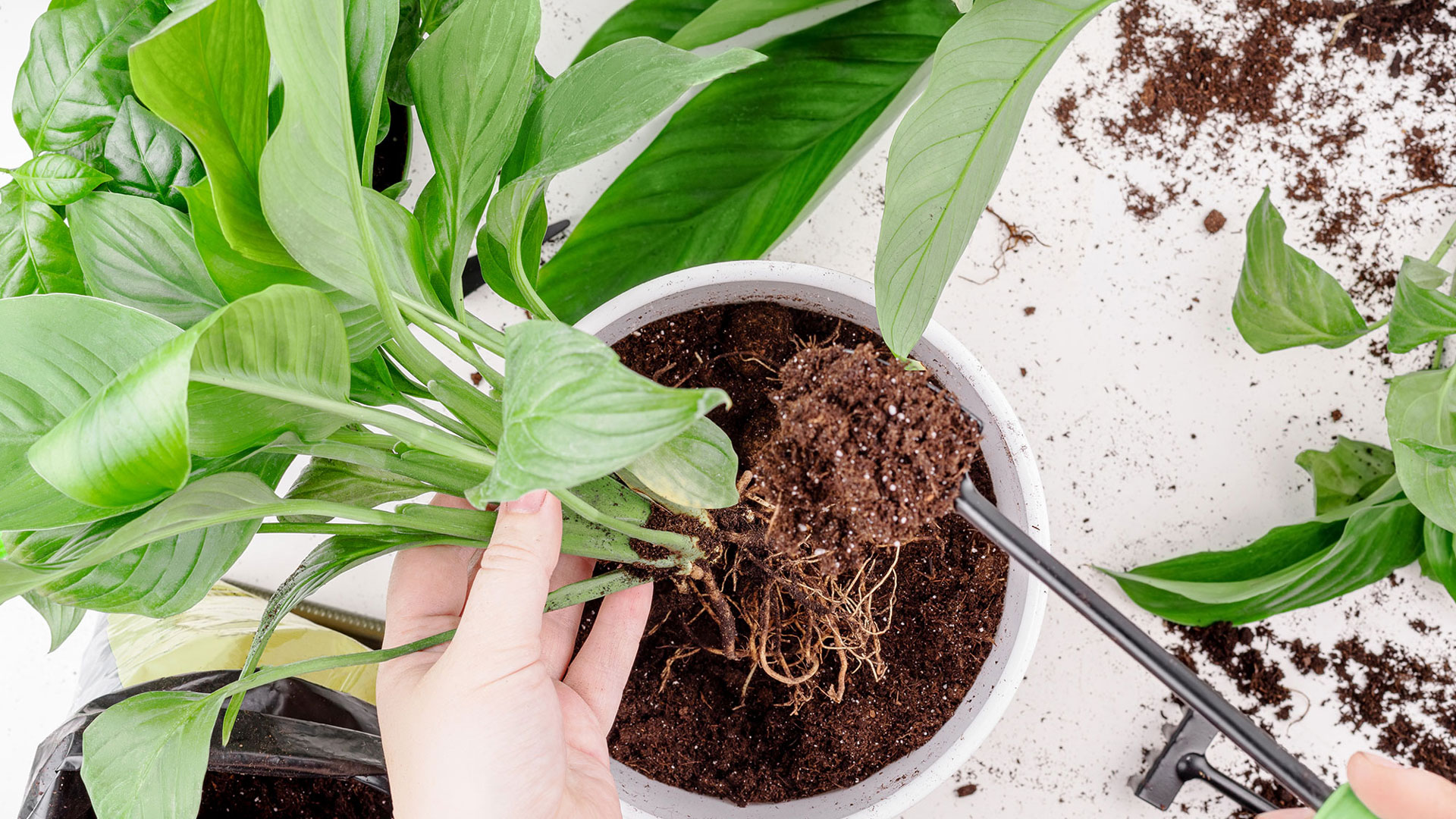
The peace lily grows quickly and makes a lovely bushy plant. If your plant is thriving and the roots are beginning to grow through the holes at the bottom of the pot, it's a sign you need to repot your plant. It's also a great time to make some babies to grow your plant collection.
Spring is the best time to repot your plant, using fresh, well-draining, multi-purpose compost. "Choose a plastic pot 1-2 sizes bigger than the existing one to give your plant room to grow," says Kelly Dryer.
"Peace lilies can be split into multiple plants by dividing the clump, ensuring each new plant has some good, strong roots to grow from. They may take some time to adjust to their new home, so don’t panic if they stop flowering for a while."
Keep an eye on repotted plants, misting the foliage regularly, and making sure the compost doesn't dry out, and soon you will have quite a collection.
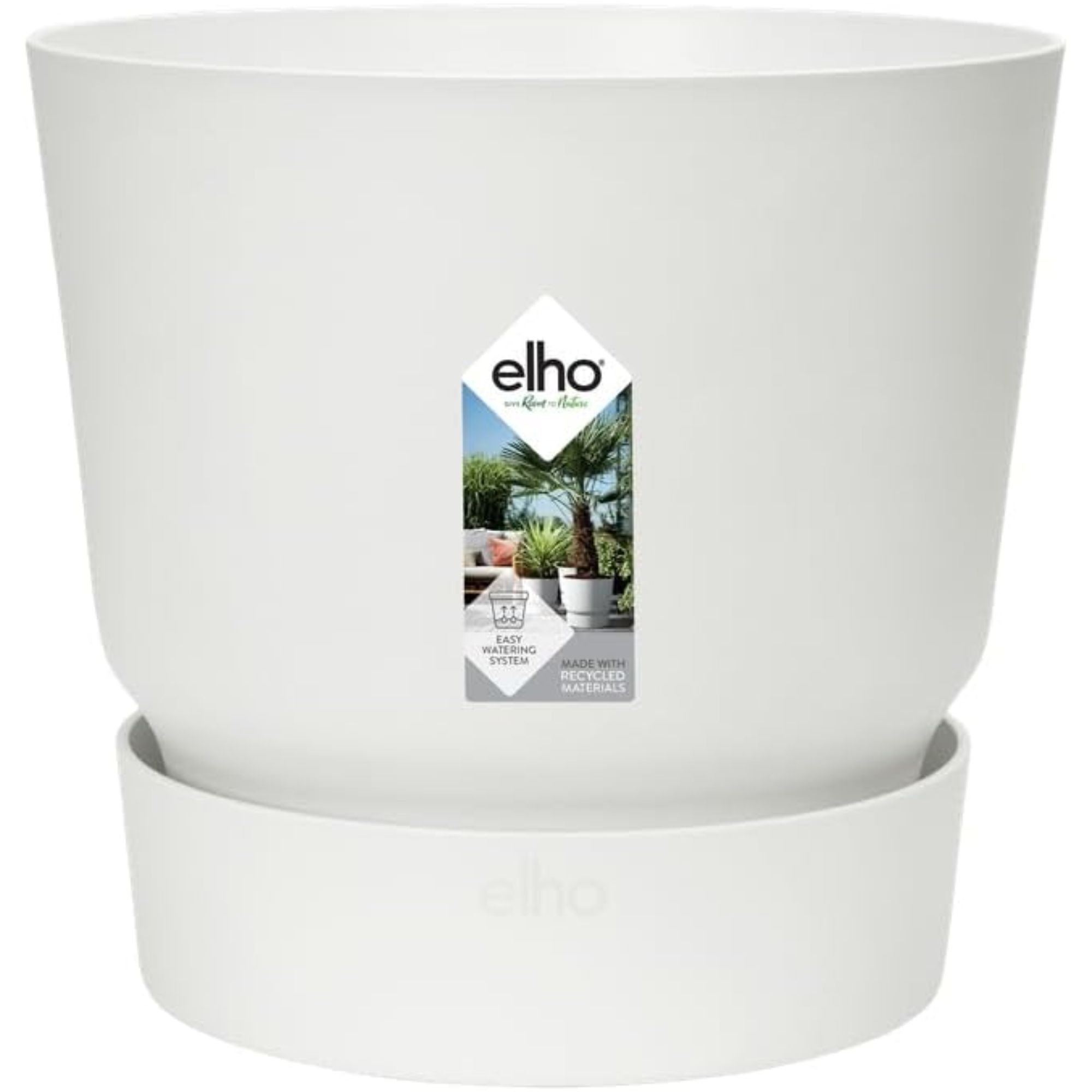
RRP: £5.89 | These are really chic, simple plant pots. Some have integrated water trays, some are made from recycled ocean plastics, and all are available in a range of colours and sizes.

RRP: £16.91 | This hand trowel does it all, from cutting through root balls to up-lifting your root-bound plant. There's even a twine-cutting notch that doubles up as a bottle opener, perfect for a mid-gardening beer.
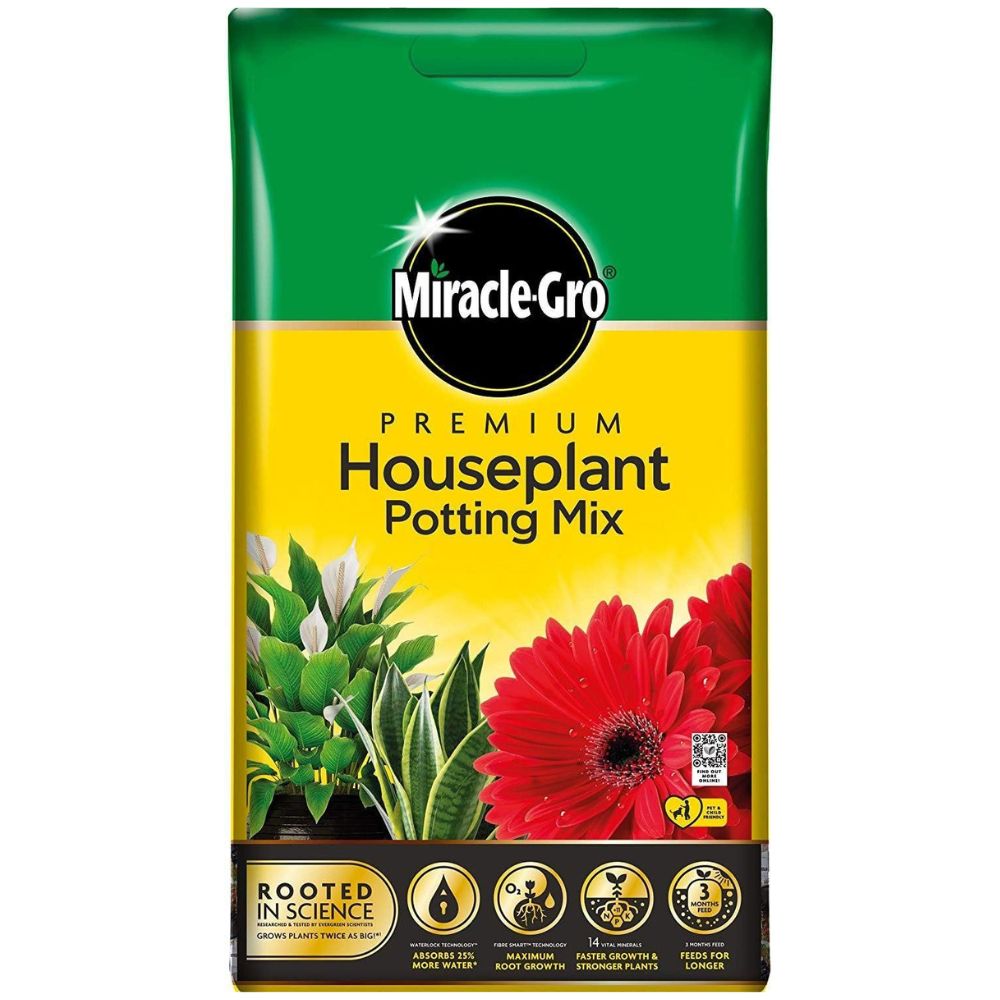
RRP: £8.39 | This mix is not only ideal for repotting your plants, it's also great for seedlings, cuttings and herbs. By choosing a specialised potting mix, your plants will have a better chance of thriving and getting all the nutrients they need.
FAQS
How do you take care of an indoor peace lily?
Take care of an indoor peace lily by ensuring it gets the right growing conditions to thrive. Remember, in their natural rainforest home, they receive dappled sunlight and consistent moisture, so aim to replicate these conditions for your plant to be healthy and happy.
One of the remarkable characteristics of peace lilies is their ability to flower almost continuously throughout the year, even in low-light conditions. They can handle most light levels but prefer a spot out of direct sunlight.
Peace lilies are low-maintenance plants, not one of the easiest plants to keep alive, but also not one of the hardest houseplants to keep alive. Requiring watering only when the soil feels slightly dry. They're not very demanding when it comes to fertiliser either, requiring a feed just once a month during the growing season.
How often must I water a peace lily?
"Peace lilies enjoy a humid atmosphere, so ideally pop them in a steamy bathroom or kitchen," says Kelly Dryer. "Grouping them with other plants can also create a humid microclimate. Lightly water them when the top two inches of their soil feels dry and keep them consistently moist."
Being left to dry out completely and then dousing them with water will only stress plants, so knowing how often to water your peace lily is the key to success when learning how to care for the plant.
How do I know if my peace lily is happy?
"A happy peace lily will have dark green, glossy leaves, and it may produce white blooms periodically," says Jess, one of the houseplant experts at The Glasshouse. "If the plant is thriving, it will maintain its overall appearance without yellowing or browning leaves.
Additionally, the plant will continue growing new leaves, indicating its health and vitality. The leaves of the plant will usually droop if it requires watering, but will perk up very quickly afterwards."
How about if your plant is unhappy? "A peace lily will let you know when it's unhappy," says Kelly Dryer. "The leaves will flop and look very wilted and sad. This is usually a sign that it needs water but it can also be a sign of overwatering so be sure that the soil is dry before giving it a drink. The trick is to keep your soil consistently and lightly moist."
If your plant doesn't recover even after watering, you can cut the foliage right down to above soil level and it will send up nice new growth in no time, so don't give up on your plant.
Peace lily leaves turning yellow or brown suggest your peace lily has been exposed to too much light. Some yellow peace lily leaves are normal, so simply remove them to make room for fresh leaf growth. Overwatering may also lead to yellowing of the leaves, so let the soil dry out a bit and see if there's any improvement. Brown edges on the leaves could indicate that your peace lily is getting too much direct sunlight. Simply move the plant to somewhere more shaded.
How long do peace lilies live?
How long a peace lily lives depends on the care you give it and the environment you put it in. Many people consider three to five years an average peace lily lifespan. However, indoor peace lilies have been known to live two decades or more.
"Like most houseplants, peace lilies can live for many years with proper care," says Jess. "On average, they can live for 5 to 10 years, but with optimal conditions and care, they have been known to live even longer, sometimes up to 15 years or more."
Should I cut the brown tips off my peace lily?
If you've ever noticed your peace lily's leaves turning brown at the tips, you may have wondered if you can remove them and whether that's beneficial for the plant.
"No matter the reason for the tips of the leaves turning brown, you can not get them to re-green, as the brown indicates that the plant tissue has died. So the best solution, not only to keep your peace lily looking good but also to prevent the spread of disease if this is the reason for brown tips, is to cut the brown, dead tissue off," starts Lucie Bradley, gardening expert at Easy Garden Irrigation.
"Always use a clean, sharp pair of scissors, snips or pruning shears, wiping the blades with rubbing alcohol to sterilise them. Carefully remove the brown tissue by cutting through the green tissue close to where it turns brown. This works perfectly for leaves with just brown tips; however, if a lot of the leaf has turned brown, you are best to remove the whole leaf, cutting through the leaf at the base," she adds.
Although this will make the plant look better, it's important you still investigate the cause of the browning to stop it from happening again.
"Unless it is because of age, what has caused the browning, such as over watering, underwatering, too much direct sunlight, too little humidity or the type of water, can be corrected so it doesn’t keep happening," explains Lucie.
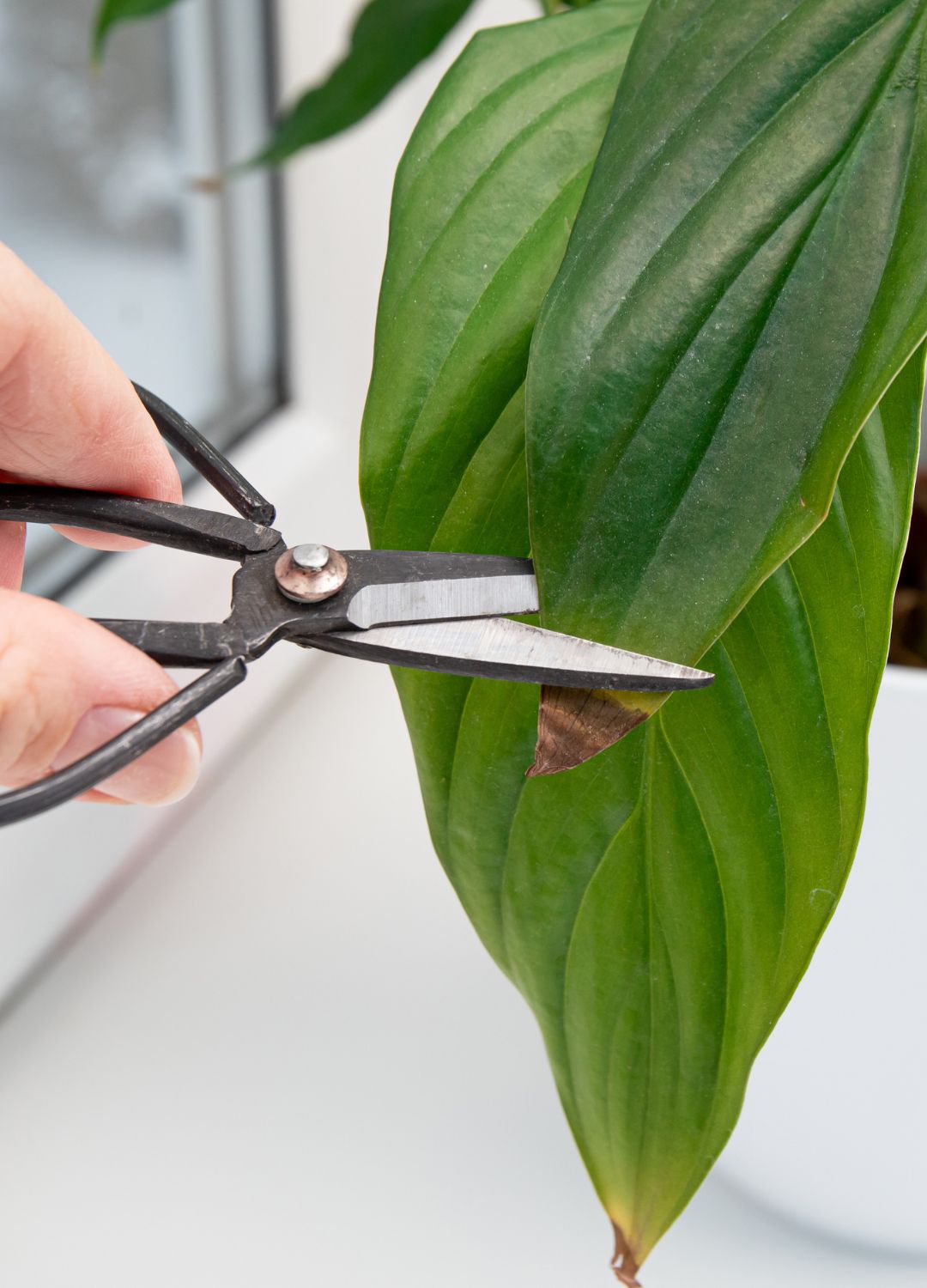
How to keep a peace lily blooming?
"If you keep your peace lily in its perfect location of bright, indirect sunlight combined with high levels of humidity and warm temperatures, then you can expect your peace lily to flower once a year in spring," starts Lucie.
"By providing the correct care, you may also be lucky enough for them to bloom a second time, in late summer, early autumn," she continues. "Their flowers should last for between 4 to 8 weeks, so it could seem as if they are in bloom all year round when they bloom twice a year."
You'll also need to feed it during the growing season, so during the spring and summer months. Using a balanced, liquid fertiliser every six weeks and watering thoroughly after each feed so the fertiliser is evenly distributed and reaches all the plants' roots.
"You should also carry out regular pruning, especially during the growing season, to ensure the peace lily can concentrate its energies on producing new growth and more blooms. This not only includes removing discoloured leaves it also means deadheading spent blooms by cutting through the faded flowers at the base of the stem," recommends Lucie.
It'll also help knowing how to repot your plant, as root-bound peace lilies tend not to flower as much. Lucie suggests repotting your plant every 1 to 2 years and doing so in early spring when it's actively growing. This will help it resettle quickly and stop any stress on the plant.
Finding out how to look after a peace lily is easy if you remember these easy pointers provided by the experts who know best.
Remember also that the peace lily is one of the most common houseplants that is toxic to cats – one to avoid if you have inquisitive pets.
Finding out how to look after a peace lily is easy if you remember these easy pointers provided by the experts who know best.
Remember also that the peace lily is one of the most common houseplants that is toxic to cats – one to avoid if you have inquisitive pets.







